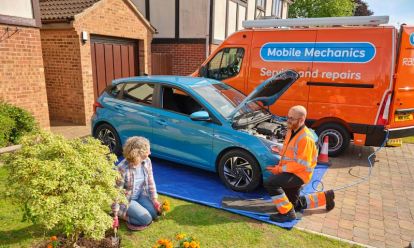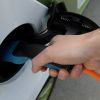Salary sacrifice schemes can be a cost-effective way to lease a new car, where you pay monthly for the car using your pre-tax earnings.
They're particularly useful for electric cars because, as the car is a business lease, you may save a fortune on company car tax, otherwise known as Benefit-in-Kind (BiK).
This guide to salary sacrifice explains how these schemes work, what the benefits are and how much you could save. It also examines the benefits for employers, along with downsides to such incentives.
What is a salary sacrifice scheme and how does electric car salary sacrifice work?
An employee on a salary sacrifice scheme (sometimes referred to as a SalSac) exchanges part of their gross (i.e., pre-tax) salary for a non-cash benefit offered by their employer. This could be used for leasing an electric car, for example.
Other common salary sacrifice schemes where money is exchanged for non-cash benefits include childcare vouchers, cycle-to-work arrangements to fund bicycles and cycling safety equipment, or indeed pension fund payments.
An overview of how salary sacrifice schemes work – including those for electric cars – can be found on the GOV.UK website.
What are the benefits for employees?
There are numerous benefits for employees who take advantage of salary sacrifice schemes.
Tax savings are a big draw, because the monthly leasing for a car is deducted from the employee’s gross salary.
This means savings can be made on income tax and National Insurance, as well as VAT.
Income tax – employees are taxed on their income, depending on how much they earn. However, as some of your earnings are deducted by a salary sacrifice scheme, your total amount of income decreases, meaning your income tax also reduces.
National Insurance (NI) – a type of tax all employees pay for state benefits including health, pensions and social care, the amount of NI you pay is calculated based on how much you earn. Both employees and employers make NI contributions. In salary sacrifice schemes, therefore, both sides of contribution make savings. For an employee, the less salary they earn (if some is sacrificed), the less NI they will pay. Equally, employers’ NI contributions are also reduced.
Value-Added Tax (VAT) – VAT is a form of tax added to nearly all consumer goods and services. Currently rated at 20 percent, VAT has to be paid if you purchase or lease an EV. When you are part of an EV salary sacrifice scheme, though, the employer pays the VAT – 10 percent of which can then be claimed back from the UK government.
Other benefits include the fact that employees can drive a brand new car with no further obligations at the end of the lease period (there is no ‘balloon payment’, as with a typical PCP finance deal, or any requirement to swap into another lease car, for example).
Usually you won't need to pay a hefty deposit at the start of the lease unlike with PCP finance, while you can also get things such as insurance, servicing, maintenance and even tyres included in the monthly payment.
Aside from salary sacrifice schemes, electric cars offer further savings for employees in terms of Benefit-In-Kind (BIK) tax and car tax (Vehicle Excise Duty), otherwise known as road tax. As they have zero tailpipe emissions, EVs currently fall into the lowest available BIK rate.
This is currently just two percent from now until 2025. Compare that to non-hybrid petrol or diesel cars, which generally attract a rate of around 25 percent. Additionally, ‘fuel’ costs – battery charging in other words – are likely to be lower, too, particularly if you can charge at home.
Factor in that electric cars are easier to drive than traditional combustion-engined cars, and more environmentally friendly at a local level, and the case for making the switch seems a strong one.
What are the benefits for employers?
There are benefits of an EV salary sacrifice scheme for employers as well. These include:
- Fully insured and maintained company cars with all in-life services (replacement tyres, for example) included
- Better employee engagement and retention
- Employee car leasing process and interaction managed by the leasing company
- Salary sacrifice schemes complement other existing employee benefits
- NI contribution savings
- Salary sacrifice schemes are HMRC and VAT compliant
- Reduced fuel costs and no upfront costs
Many companies are looking to reduce their overall carbon footprint, and moving employees to eco-friendly transport at little cost to the business is a cost-effective way of doing so.
If there is a downside, it’s the obligation to pay VAT on the leased car, although 10 percent of this can be claimed back from the government. Savings in National Insurance contributions also help to mitigate this.
Get a service or repair at home
RAC Mobile Mechanics can come to you, saving you the hassle of going to a garage.


Salary sacrifice schemes: how much could you save?
Example 1: Tesla Model Y
If you were a manager earning £50,000 a year, leasing a Tesla Model Y Long Range through a standard lease agreement over 48 months and driving 10,000 miles a year, you could potentially save £139 a month if you leased the car through a salary sacrifice scheme.*
Let’s break down and compare the costs of a standard lease agreement with a salary sacrifice scheme.
Standard lease agreement
Your gross monthly salary would be £4,167, and you would pay £624 per month in income tax, along with £443 in National Insurance. Your monthly take-home pay (otherwise known as your monthly net salary) would be £3,100.
Let's say your monthly salary sacrifice payment on a Tesla Model Y Long Range is around £653, with no deposit and servicing and maintenance included. Under the agreement, this would be paid out of your net monthly salary of £3,100.
After tax has been paid from your net monthly salary, and after you have paid the leasing fee, you would have £2,447 left.
| Gross monthly salary | £4167 |
|---|---|
| - minus income tax | -£624 |
| - minus National Insurance | -£443 |
| Net monthly salary | £3100 |
| - leasing price | -£653 |
| Monthly remaining salary | £2447 |
Salary sacrifice scheme
Using an EV salary sacrifice scheme, with a gross monthly salary of £4,167 and a gross salary sacrifice of £544 (the leasing cost of £653 minus the VAT), your gross monthly salary would reduce from £4,167 to £3,623.
You would then be taxed on this income, and pay £624 of income tax and £413 of National Insurance. Your net monthly salary would then be £2,586.
| Gross monthly salary | £4167 |
|---|---|
| - salary sacrifice | -£544 |
| Gross monthly salary minus salary sacrifice | £3623 |
| - minus income tax | -£624 |
| - minus National Insurance | -£413 |
| Net monthly salary | £2586 |
Using a salary sacrifice scheme rather than a standard lease agreement, therefore, you could potentially save £139 per month.
Example 2: Volkswagen ID.3
If you were an office worker earning £35,000 per year, leasing a Volkswagen ID.3 Match Pro S 77kWh through a standard lease agreement over 48 months and driving 10,000 miles a year, you could potentially save £87 a month if you leased the car through a salary sacrifice scheme.*
Standard lease agreement
Your gross monthly salary would be £2,917, and you would pay £374 per month in income tax, along with £248 in National Insurance. Your monthly take-home pay (otherwise known as your net monthly salary) would be £2,295.
Lets assume the salary sacrifice leasing price for a Volkswagen ID.3 77kWh is around £520, with no deposit and servicing and maintenance included. Under the agreement, this would be paid out of your net monthly salary of £2,295.
After tax has been paid from your net monthly salary, and after you have paid the leasing fee, you would have £1,775 left.
| Gross monthly salary | £2917 |
|---|---|
| - minus income tax | -£374 |
| - minus National Insurance | -£248 |
| Net monthly salary | £2295 |
| - leasing price | -£520 |
| Monthly remaining salary | £1775 |
- How much does it cost to charge an electric car?
- The costs of running an electric car
- Electric car charging – how it works and how much it costs
Are there any downsides to a salary sacrifice scheme?
For an employee, a salary sacrifice scheme has few downsides.
While it could save you a significant amount of money each month, that may not make it the most affordable way to access an EV.
Buying a used car outright is still likely to be cheaper overall. Also, leasing a car means you will never end up owning it – so it could also prove more expensive for those who want to keep a car long-term.
It's also worth noting that the monthly payments on a salary sacrifice scheme cannot take your take-home pay below the national minimum wage. This will be worked out prior to any agreement being made to see if you're eligible.
Conclusion
Employees of companies that run a salary sacrifice scheme should definitely investigate how much they could potentially save – particularly by choosing an EV. Find out more by visiting our electric car leasing guide.

RAC sale – up to 33% off*
• Roadside cover from £5.29 a month†
• We get to most breakdowns in 60 mins or less
• Our patrols fix 4/5 breakdowns on the spot











